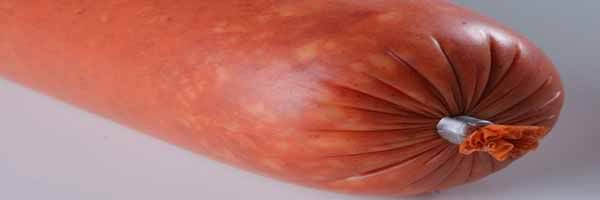
* Mucosa or lining of mucosa or saliva composed of cells that aid in digestion, absorption and circulation of substances to the various parts of the body.
* Submucosa — nerves and fibers with fatty tissues in them. These are rich in collagen, the chief material in casing.
* Smooth muscles that surround the intestine.
* Layer of fibers.
* Serosa (outermost layer), composed of thin elastic fibers.
* Cow serosa is thicker than hog serosa.
Procedure:
Carefully pull the intestines from the slaughtered animal.
Fat removal:
Carefully scrape the fat with a knife. Remove all fat as much as possible because this will cause rancidity in the casings. This fat can be used for cooking. When pulling the intestines from the slaughtered pig or sheep, remove as well the adhering hairs, from the intestines. If it will facilitate, the intestines can be cut in pieces according to need.
Removal of other materials:
This can be done manually carefully or by means of a water hose for cleaning as well.
Removal of slimy substance:
The removal of slime depends on the kind and size of the intestine. It may be cleansed by passing the intestine under a roller, or by scraping it to remove the serosa. Bigger intestines are flushed with water or turned inside out. After cleaning, soak the casing overnight in strong salt solution.
Grading and Storing:
The grading of casings is according to class, size and quality. The higher quality (or export quality in the U.S.) is that which is free from defects like holes, bruises or warts. After grading this is pumped with air or with water to enable the measuring of the circumference. Hog and sheep casings are marketed in lengths of 90 meters more or less, and those of cows by 30 meters. After grading, these are salted with fine salt and stored further, and drained if wet.
After draining, it is further shaken to remove any remaining water and salted again if necessary.
Storage:
Casings packed in salt get deteriorated too. These have to be put in 4°C temperature, but freezing must be avoided, as it could cause cracks that will be the start for the growth of molds. Avoid also the growth of red molds that thrive on salt. This will cause the decay of the casings.
Other Casings:
1. Cow bladder — after cleaning, air dry them. When dry, they are ready for marketing.
2. Hog or sheep intestine parts — these are joined together into various shapes. To make the edges adhere together, these are passed through heat and then joined together.
3. When cool and dry, they are packed and are ready for marketing.
source: elgu2.ncc.gov.ph, photo from forums.egullet.org












Comments :
Post a Comment